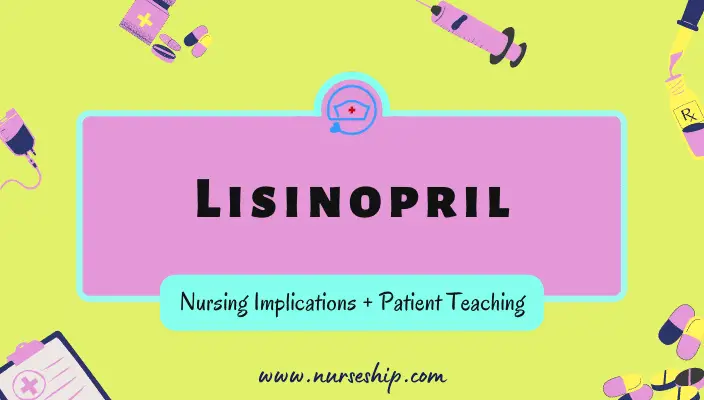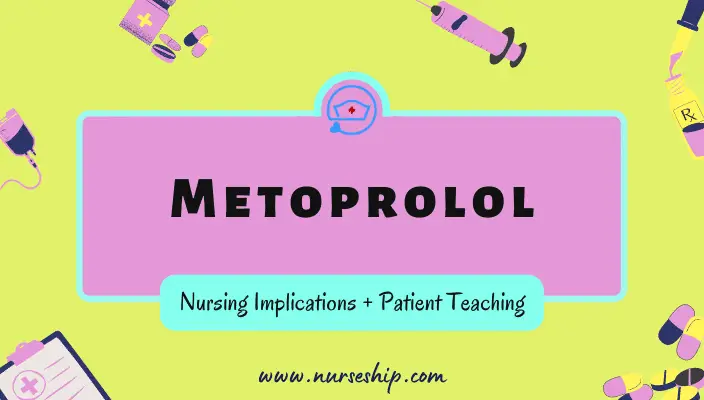Introduction
In this article, you’ll learn about Lisinopril’s nursing implications and patient teachings. Also, its dosage, indication, side effects, nursing assessment, nursing interventions, and nursing diagnoses.
Lisinopril is an angiotensin-converting enzyme (ACE) inhibitor that is used to treat high blood pressure. It is also used to treat heart failure and myocardial infarction. It is usually the first line of treatment for high blood pressure. Lisinopril is used as a prophylactic after myocardial infarction.
Generic Name: Lisinopril
Brand Names: Prinivil, Zestril, Qbrelis, Zestoretic
Lisinopril Class and Category
Pharmacologic class: Angiotensin-converting enzyme (ACE) inhibitor
Therapeutic class: Antihypertensive
Pregnancy category: C in 1st trimester and D in 2nd & 3rd trimesters.
Lisinopril Dosage
To manage hypertension
- Adults: PO:10-40 mg/day; maximum: 80 mg/day
- Children (6 years and older): PO: initially 0.07 mg/kg/day (up to 5 mg/day); titrate every 1-2wk; Maximum: 0.6 mg/ kg/day or 40 mg/day.
- Geriatric: 2.5-5 mg/day; increase every 7 days.
To treat heart failure
- Adults: 2.5 – 5 mg/day; maximum: 20 – 40 mg/day.
To treat acute myocardial infarction
- Adults: Give 5 mg within 24 hours of onset of symptoms, then 5 mg after 24 hours, 10 mg after 48 hours, then 10 mg daily.
Lisinopril Pharmacokinetics and Pharmacodynamics
| Route | Onset | Peak | Duration |
| PO | 1 hr | 6-8 hrs | 24 hrs |
Absorption: Incomplete absorption from the GI tract.
Distribution: protein binding 25%.
Metabolism: Does not undergo metabolism
Half-life: 12 hours
Excretion: Excreted unchanged in the urine
Lisinopril Mechanism of Action
In the renin–angiotensin–aldosterone system (RAAS), it prevents angiotensin-converting enzyme (ACE) from converting angiotensin I to angiotensin II.
Angiotensin II is a potent aldosterone release stimulant and direct vasoconstrictor. When angiotensin II levels are reduced, the arterioles relax, which reduces aldosterone release from the adrenal cortex, allowing the kidney to excrete sodium and water in the urine.
Potassium ion retention improves as a result of this. In the kidney’s peritubular capillaries. The RAAS process is suppressed, resulting in a reduction in total blood pressure.
What are the indications of Lisinopril?
Lisinopril indications include:
- To treat hypertension
- To treat heart failure
- To treat acute myocardial infraction (AMI)
Off-label uses include diabetic nephropathy/ retinopathy, proteinuria, post-myocardial infraction
What are the contraindications of Lisinopril?
The contraindications of Lisinopril are:
- Hypersensitivity to lisinopril or its components
- Angioedema
- Concomitant usage with aliskiren in patients with type 2 diabetes
- Co-administration or use of a neprilysin inhibitors (eg, sacubitril), during the past 36 hours
Caution: Breastfeeding, renal failure, hyperkalemia, hyponatremia, renal artery stenosis, heart failure, aortic stenosis, CVA, systolic BP less than 100 mmHg, surgery/anesthesia.
Lisinopril Interactions
- Lisinopril increases hyperkalemia with potassium-sparing diuretics, potassium supplements, cyclosporine.
- Lisinopril’s hypotensive effect is increased with diuretics, other anti-hypertensive, probenecid, phenothiazines, nitrates, acute alcohol ingestion.
- NSAIDS may result in deterioration of renal function, including possible acute renal failure with Lisinopril. The antihypertensive effect of Lisinopril, may be reduced by NSAIDs.
- Concomitant use with lithium may cause lithium toxicity.
- Lisinopril use with glucose lowering drugs increased blood-glucose-lowering effect while increasing the risk of hypoglycemia.
- Possible nitritoid reaction (eg; facial flushing, hypotension, tachycardia, nausea, vomiting) with gold (injectable form such as sodium aurothiomalate)
- Concomitant use with mechanistic target of rapamycin (mTOR) inhibitor or neprilysin inhibitor may increase the risk of angioedema
- Lisinopril can increase LFT anf RFT values.
- Lisinopril may result in a positive ANA titer.
- Lisinopril may lower serum sodium levels.
Herbal/food interaction
Lisinopril increases the risk of hyperkalemia with a high-potassium diet and potassium supplements. Some of the potassium-rich foods are listed below.
- Banana
- Potatoes
- Pork
- Tomatoes
- Avocado
- Strawberries
- Spinach
- Fish
- Mushrooms
- Cantaloupe
Potassium-rich herbs include bayberry, blue cohosh, cayenne pepper, ephedra, and licorice.
What are Lisinopril side effects?
Lisinopril side effects/ adverse reactions include:
- Hypotension
- Vertigo
- Insomnia
- Paresthesia
- Tachycardia
- Nasal congestion
- Nausea and vomiting
- Constipation/diarrhea
- Hepatic failure
- Renal insufficiency
- Pancreatitis
- Impotence
- Sexual dysfunction
- Neutropenia
- Pruritus
- Muscle cramps
- Dyspnea
- Dry cough
- Hypoglycemia
- Life-threatening adverse effects: angioedema, toxic epidermal necrolysis, agranulocytosis, hyperkalemia
| Black Box Warning! |
| STOP using Lisinopril as soon as possible if a pregnancy is detected. |
Lisinopril Nursing Implications [Nursing Considerations]
Lisinopril nursing implications are divided into nursing assessment, nursing diagnosis, nursing interventions, and evaluation.
Lisinopril nursing assessment
- Obtain complete medical history from patient. History should include hypersensitivity to ACE inhibitors, angioedema, aortic stenosis, toxic epidermal necrolysis.
- Assess blood pressure and apical for rhythm, quality before Lisinopril administration
- Obtain a baseline basic metabolic panel (BMP) (especially, BUN, creatinine, Na+, K+; CrCl, GFR).
- Obtain baseline CBC in patients with renal failure or autoimmune disease, or on immunosuppressants.
- Assess the hemodynamic status of acute MI patient. Lisinopril should not be given to hemodynamically unstable patients.
- Assess hydration status (eg; skin turgor, dryness of mucous membranes) of the heart failure patients before administering Lisnopril.
Lisinopril nursing diagnosis
- Decreased cardiac output (indication + adverse effect)
- Risk of fall (adverse effect)
- Anxiety related to threat to health status
- Deficient knowledge related to drug regimen
Lisinopril nursing interventions/ actions
- Monitor patient for worsening signs of heart failure (such as pitting edema, weight gain, dyspnea, crackles).
- Closely observe patient for signs of angioedema (such as face, extremity, eye, lip, and tongue swelling, trouble swallowing, dyspnea).
- Monitor the patient for anaphylaxis, especially those being dialyzed with high-flux membranes and those undergoing low-density lipoprotein apheresis with dextran sulfate absorption.
- Monitor for hydration status, especially patient who is experiencing diarrhea and vomiting. Because it can cause hypotension.
- Monitor blood glucose level closely in diabetic patients who are on oral hypoglycemics or insulin. Because Lisinopril increases the risk of hypoglycemia.
- Monitor CBC, RFTs, LFTs periodically. Because Lisinopril can cause neutropenia, hyperuricemia, cholestatic jaundice or hepatitis.
- Monitor serum potassium, serum sodium, and serum chlorine levels. As Lisinopril has the potential to cause hyperkalemia and hyponatremia.
Evaluation
Evaluate the effectiveness of Lisinopril: for reduced blood pressure; adherence to the treatment regimen, minimal/no undesired adverse effects.
Pregnancy/breastfeeding considerations for Lisinopril
- Lisinopril has potential to cause fatal harm (such as fetal kidney damage, lung hypoplasia, skeletal defects, death) to the fetus. Hence the medicine should be stopped as soon as a pregnancy is detected.
- Whether Lisinopril excretes via breastmilk is not known. Therefore, consult with prescriber before resuming Lisinopril therapy during lactation.
What is the nurse patient teaching for Lisinopril?
- Teach the patient need to take drug as ordered, even if patient feels well, not to discontinue the drug abruptly; tapper off according to physician’s order.
- Instruct patient to report dizziness, especially during first few days of therapy.
- Instruct the patient to avoid swift movements to minimize orthostatic hypotension.
- Advise the patient to avoid hazardous activities such as driving until dizziness or other nervous system symptoms subsides.
- Counsel the patient to minimize potassium in the diet.
- Teach the patient about risk of developing hyperkalemia. Especially, patients with diabetes or renal insufficiency, or patients who are also taking potassium sparing diuretics, potassium containing salt substitutes, or potassium supplements.
- Explain to the patient that lifelong therapy may be needed. Because Lisinopril helps to control, but doesn’t cure, hypertension.
- Teach the patient signs of angioedema and advise the patient to seek immediate emergency treatment if she experiences dyspnea or difficult in swallowing or notices swelling of his/her eyes, extremities, face, lips, or tongue.
- Advise the patient to take Lisinopril at the same time every day.
- Inform the patient that persistent, nonproductive cough may develop during Lisinopril therapy. Notify prescriber immediately, if cough becomes difficult to tolerate.
- Advise patient to drink adequate fluids and avoid excessive sweating, which can lead to dehydration and hypotension.
- Instruct patient to report signs of infection, such as fever and sore throat, which may indicate neutropenia.
- Advise the childbearing age females to notify prescriber immediately if she is or could be pregnant because the drug needs to be discontinued.
Treatment of Overdose for Lisinopril
- Gastric lavage
- Symptomatic treatment. For example, bradycardia is treated with IV atropine, bronchospasm is treated with IV theophylline, digoxin, Oxygen therapy, diuretics for cardiac failure.
Conclusion
You learned about lisinopril nursing implications (aka nursing considerations) and patient teaching in this article. In addition, you’ve learned about lisinopril’s mechanism of action, pharmacokinetics, dosage, indications, contraindications, and side effects.
Recommended Readings & Reference
FDA Lisinopril (ZESTRIL) information
Kee, J., Hayes, E., & McCuistion, L. (2015). PHARMACOLOGY A Patient-Centered Nursing Process Approach (8th ed.). Elsevier Inc/Saunders.
Kizior, R., & Hodgson, K. (2021). SAUNDERS NURSING DRUG HANDBOOK 2021. Elsevier Inc.
Jones & Bartlett Learning. (2021). Nurse’s Drug Handbook (20th ed.). Jones & Bartlett Learning, LLC.
Skidmore-Roth, L. (2021). MOSBY’S 2021 NURSING DRUG REFERENCE (34th ed.). Elsevier Inc.




